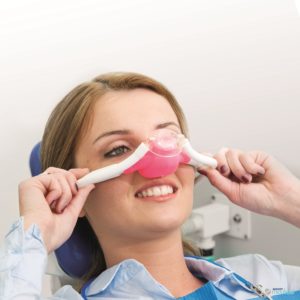Going to the dentist can be daunting but it’s a lot worse for people with a hypersensitive gag reflex. It can make short appointments uncomfortable and long appointments unbearable. So what can you do about it? Find out as we explore management techniques to make your dental appointment much more enjoyable.

Why Do You Gag?
The severity of the gag reflex differs from person to person but it is generally a physiological problem. The gag reflex (a.k.a. pharyngeal reflex) is essentially your body’s defence mechanism. It protects your body from unwanted or alien substances/objects going down your throat or blocking your airway. Either way, it’s protecting you from choking.
However, when the conversation turns to gagging at the dental clinic, a psychological factor could also contribute to your gag reflex. Dental appointments seem stressful already, and if you’ve had a traumatic experience in the past, that fear and anxiety can heighten your tendency to gag while you’re having your teeth treated.

So What Should You Do?
There are a few things you can do to reduce your tendency to gag and manage that reflex during your dental appointment.
1. Breathe… Just Breathe
Your gag reflex is protecting you from an obstructed airway. You’re likely to breathe through your mouth during your appointment because it’s natural to want to breathe through your mouth when it’s open. Chances are, however, your dentist’s hands or instruments will be in your mouth at the same time and you’ll feel like you can’t breathe, triggering your gag reflex.
Instead, concentrate on breathing through your nose. A deep inhale for seven seconds, holding your breath for three seconds, then exhaling for eight seconds is a very effective distraction. These weird, odd numbers gets you concentrating on your breathing pattern, not on any potential oral obstructions.

Alternatively, focus on breathing deep into your diaphragm. This sort of breathing is proven to aid relaxation and reduce any stimulation of the sympathetic nervous system (in control of fight-or-flight responses, such as the gag reflex).
If you find it difficult to breathe through your nose, it’s best to come prepared before the appointment by taking nasal decongestants so that you don’t feel like you’re choking.

2. Time to Go
Try not to book a morning appointment if you can help it. For some people, they have more of a tendency to gag earlier in the day. If that’s you, try to find an appointment time in the afternoon or evening, when your gag reflex will be less likely triggered. If you find it’s the opposite, adjust your appointment time accordingly.

3. Spray Away
The use of numbing throat sprays or snore relief sprays can be very effective for some people. Spray either of these immediately before treatment. Numbing throat sprays generally last an hour after spraying and you can get either of these over the counter at your local chemist.

4. Don’t Wallow in Your Swallow
Drooling is cute when dogs do it but not so cute when humans do it. Unfortunately, you may have to resign yourself to a little bit of drool while you’re in the dental chair.
When you have your mouth open, your mouth’s natural response is to produce saliva to wet your increasingly dry mouth. However, when you’ve got a dentist’s hands and instruments inside your mouth, the pooled saliva eventually has to go somewhere: either out of your mouth or you need to swallow it.
It’s hard to swallow anything while lying down. If you try to swallow your saliva during an appointment, it could very easily trigger your gag reflex as your body registers this difficulty to swallow as you choking. So try not to swallow while you’re in the dental chair to avoid worsening the experience.

5. Getting Salty
This may seem a bit bizarre but this actually works: placing a bit of salt on the sides of your tongue. Or you can just swish a saltwater solution in your mouth and then spit it out. Tasting salt on your tongue helps to diminish your gag reflex.

6. Thumbs In
This technique is thumbs up all the way but not literally. If you close your left thumb in your left hand by making a tight fist, your gag reflex can be countered and distracted.
This technique was proven in 2008 when a study was conducted while participants were undergoing dental treatment. When they gripped their left thumb in a tight fist, they were immediately soothed. It may work just as well for you.

7. Hum Fun
Little known fact: you can’t hum and gag at the same time. Most dental surgeries have music playing in the background. If you hum along while the dentist’s instruments are in your mouth, you’ll find that it counteracts any gag reflex you may have.

8. Distraction Action
Just like the breathing and thumb techniques, finding ways to distract yourself is an effective way to lessen your chances of engaging your gag reflex. You can add squeezing a stress ball, listening to music through headphones, or even employing self-hypnosis to your distraction repertoire. By allowing your mind to wander, you also deal with the psychological trigger for your gag reflex.

9. Don’t Be So Sensitive!
Employing desensitization techniques before your dental appointment could be a great way to prepare and reduce your soft palate’s gag-inducing sensitivity to touch.
Brush your teeth and find the spot where your gag reflex begins engaging. Brush that spot for 10 seconds. Repeat this for several nights in a row and you build up a level of desensitization to the stimulation.
Gradually move your toothbrush further and further into the gag zone over the course of a month. It’s not entirely pleasant but it is worth it if you’re concerned about gagging during a dental treatment.

10. Work Those Abs
For some people, tightening their abdominal muscles might help them suppress their gag reflex. You can do this by raising your legs slightly off the dental chair and holding it, not allowing it to drop back onto the chair.
Obviously, this may not be the most feasible solution if your treatment goes for an hour or two. But in short appointments, like check ups an cleans, doing this when you feel your gag reflex coming on could help for short bursts.

11. Under Pressure (Point)
The Hegu Point is the fleshy part of your hand between your thumb and index finger. When you apply pressure to that area by squeezing it with your other hand, it alters the gag reflex, calms you, and makes the sensation more tolerable.
This method works for 5-20 minutes so it’s effective for shorter treatments. You should note, though, that if your skin starts feeling the pain of the pressure, it means your gag reflex will be on the verge of return.

What Can Your Dentist Do?
1. First Port of Call
Your dentist doesn’t just specialise on your teeth: they’re also there to take care of you and they’re more than happy to talk to you about dealing with any of your concerns. If you’re struggling managing your gag reflex, speak to your dentist and they’ll tailor your treatment to suit your needs.

2. Painkill Not Joykill
Your dentist can apply a topical anaesthetic spray or gel to the roof of your mouth, back of your tongue or throat. That way, those sensitive areas will be numb while they work and it will eliminate the physiological gag reflex trigger.

3. A New Position
Generally dentists treat patients lying down. However, there are exceptions. If you have a severe gag reflex, your dentist may be able to work on you when you are seated in a more upright position. That way, saliva won’t flow to the back of your mouth and trigger your gag reflex.

4. Damming Your Mouth
Rubber dams are often used for endodontic procedures but it can also be used for other treatments. It provides a barrier that prevents fluids and other dental debris from entering your mouth and throat, accidentally triggering your gag reflex.
It does, however, require your mouth to be open the entire time so that you don’t bite through the rubber dam, and this could be quite tiring for your jaw. If you’re undergoing a lengthy dental treatment with the rubber dam, you can ask your dentist for a bite block to rest your jaw.

5. Sleeping on the Job
Depending on which dentist you go to (a general dentist, a specialist, or even the hospital), there are all sorts of dental sedation available.
Essentially, if you undergo general anaesthesia in the hospital, you’ll be knocked out for the entire procedure and obviously you won’t feel a thing, including your gag reflex.
Your general dentist can also provide a mild sedation called “happy gas” (nitrous oxide) which you just breathe in. It keeps you fully conscious but very relaxed and it has been shown to be effective with managing your gag reflex.

Whichever method you decide to implement, always speak to your dentist first. They’ll be able to advise you what is the most appropriate course of action and partner with you to get the best results.

